How to use the soil food web to benefit your garden
Did you know that 22 lbs of the human body is made up of bacteria? These bacteria live in our guts, nostrils, ears, and mouths. Likewise, there are almost 10 billion microbes in one teaspoon of healthy garden soil. One teaspoon of healthy soil will contain 75,000 different species of bacteria, 25,000 different species of fungi, 1,000 species of protozoa, 100 to 1,000 individual micro arthropods, 50 species of nematodes, of which 10 to 15 are bacteria eating nematodes, 5 to 10 are fungal feeding nematodes, and 1 or 2 are predatory nematodes. When a team of microbiologists studied the roots of a sugar beet, they discovered more than 33,000 microbes on the roots alone.
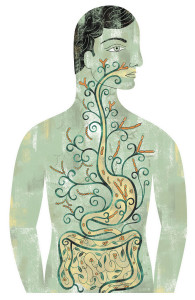 Most people think of bacteria as a germ or a bad thing, but there are good or beneficial bacteria as well. People can die of bacterial infection, yet we would also die if we didn’t have the the good bacteria, the probiotics in our gut to help us break down food and extract its nutrients. Plants have a similar relationship with the bacteria and other microbes in the soil. Without them, the plant would not get the nutrients it needs to survive.
Most people think of bacteria as a germ or a bad thing, but there are good or beneficial bacteria as well. People can die of bacterial infection, yet we would also die if we didn’t have the the good bacteria, the probiotics in our gut to help us break down food and extract its nutrients. Plants have a similar relationship with the bacteria and other microbes in the soil. Without them, the plant would not get the nutrients it needs to survive.
Everyone knows that plants grow in soil, but did you know that plants don’t get their nutrients directly from the rocks and minerals in the soil. They actually feed off the waste products of the soil fauna. The microbiology in the soil breaks down the soil and turns it into water soluble nutrients that the plant’s roots can absorb.
Scientists have discovered that plants actually release food for the soil organisms through there roots. This food, called exudates, is composed of simple sugars, proteins, and carbohydrates. Plants and the soil microbiology have developed a symbiotic relationship where the microbes get food from the plants and in turn they provide nutrients to the plants. This adaptation is so honed in that plants release different kinds of exudates to attract different types of microbes based on what the plants need at that time.
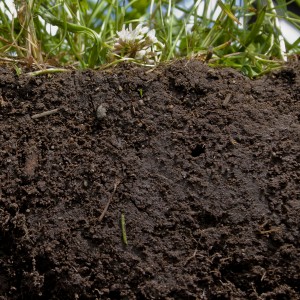 This relationship is what makes the soil food web so important. The soil food web consists of all of the living creatures that interact with the soil, above and below the surface. It not only contains microbes, which are invisible to our eyes, but also earthworms, nematodes, beetles, mold, fungi, mites, and micro arthropods.
This relationship is what makes the soil food web so important. The soil food web consists of all of the living creatures that interact with the soil, above and below the surface. It not only contains microbes, which are invisible to our eyes, but also earthworms, nematodes, beetles, mold, fungi, mites, and micro arthropods.
These soil microbes provide nitrogen, phosphorus, potassium and many other nutrients to our plants. This is how it works: The bacteria eat the exudates produced by the plant roots. In the process of eating the exudates they also break down and take in nutrients from the rock, clay and silt. Then the bacteria are eaten by the protozoa and nematodes. Finally, the protozoa generate waste that contains the vital nutrients the plants were looking for. The soil food web also helps provide water to our plants. Beneficial fungi attach themselves to the roots and create a pathway in the soil literally extending the plants root system to bring more water and nutrients to the plant. The fungi also protect the plant from harmful soil organisms.
In this series of soil articles, you have learned about how to find out your soil type, how to prepare healthy soil, how to protect your soil, and how to make great compost. Now, you will learn about the microbes that live in the soil and how they affect your plants. I’ve divided this article into two main sections:
1. Soil biology: Understanding Soil Microbiology for Organic Gardening
In this section, we will learn about microbes and other creatures living in the soil. We will learn about different kinds of microbes such as bacteria, protozoa, Amoebae etc. and how they help your plants. We will also learn about creatures of the soil such as earthworms, nematodes, and beetles and how they affect the plant growth. This section tries to answer questions like:
- What are soil microorganisms and soil critters?
- What are healthy soil microbes and how do they contribute to plant health?
- How to identify potential problems and how to correct them using organic means?
2. Soil Food Web: How to Apply Soil Food Web in Organic Gardening
The organisms and creatures living in the soil are commonly referred to as the soil food web. This section tells about the community of organisms in the soil and how they interact with plants, animals, each other and the environment. We will also learn about various functions of soil organisms, and how we can use organic matter to fuel the food web. This section tries to answer questions like:
- What is the soil food web and why should gardeners care?
- What does the soil food web looks like?
- How does the soil food web apply to gardening?
- What are the tools for restoring and maintaining a healthy soil food web?
Soil Microbiology
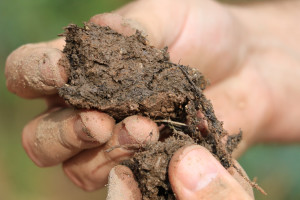 “We know more about the movement of celestial bodies than about the soil underfoot,” said Leonardo Da Vinci five hundred years ago. How right he was. In one teaspoon of soil, there are more microbes than the population of the earth. The survival of the human race depends on the plants we grow for food, and the plants we grow depend on the microbiology living in our soil.
“We know more about the movement of celestial bodies than about the soil underfoot,” said Leonardo Da Vinci five hundred years ago. How right he was. In one teaspoon of soil, there are more microbes than the population of the earth. The survival of the human race depends on the plants we grow for food, and the plants we grow depend on the microbiology living in our soil.
What is Soil Microbiology?
Soil microbiology is the branch of science that studies the organisms living in the soil. Soil microbiology studies the functions of soil organisms, how they interact with the soil and the plants. Soil microorganisms are very important because they help in the growth of plants by affecting soil structure and soil fertility.
The first microorganism evolved between two and four billion years ago. It was a unicellular bacterium. These bacteria multiplied through the process of cell division. These bacteria trapped nitrogen from the atmosphere and released oxygen into the atmosphere. Slowly, the earth became suitable for more advanced microorganisms.
The soil can be divided into two basic parts:
Minerals are the vital nutrients in the soil. They are the non-living portion of the soil which consists of rock particles like sand and silt, and organic matter like compost.
The soil food web consists of all of the living organisms in or around the soil, good or bad. There are various types of soil organisms. Some of them are very beneficial to the plants as they provide vital nutrients and help in the growth of plants. These good soil organisms are also called biota. Some soil organisms have an adverse effect. They cause various problems such as rots blights, molds, and mildews. These bad soil organisms are called pathogens. Biota and pathogens each have their own importance in the soil food web.
The Different Types of Soil Organisms
The soil food web has an incredible diversity of organisms that range from the minute unicellular bacteria, protozoa, algae, and fungi to the complex micro-arthropods and nematodes, and the visible insects, small vertebrates, earthworms, and plants. Here are some details on the various kinds of soil organisms.
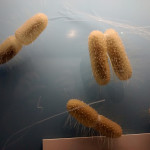 Bacteria – The soil is full of both beneficial and pathogenic bacteria. The beneficial bacteria help the plants by recycling organic matter, which provides vital nutrients to the plant. One of the beneficial bacteria in the soil is the nitrogen-fixing bacteria. These bacteria fix nitrogen from the atmosphere and provide nitrogen to the plant roots. These bacteria dine on organic matter and create a waste product called bacteria manure. The bacteria manure contains vital nutrients for the plant. Other soil organisms also eat bacteria and the bacteria’s waste to generate other nutrients the plants need. Bacteria are especially sensitive to herbicides and pesticides.
Bacteria – The soil is full of both beneficial and pathogenic bacteria. The beneficial bacteria help the plants by recycling organic matter, which provides vital nutrients to the plant. One of the beneficial bacteria in the soil is the nitrogen-fixing bacteria. These bacteria fix nitrogen from the atmosphere and provide nitrogen to the plant roots. These bacteria dine on organic matter and create a waste product called bacteria manure. The bacteria manure contains vital nutrients for the plant. Other soil organisms also eat bacteria and the bacteria’s waste to generate other nutrients the plants need. Bacteria are especially sensitive to herbicides and pesticides.
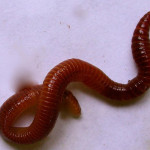 Earthworms are one of the most beneficial soil organisms. They have two major functions: aeration and providing soil nutrients. When earthworms tunnel through the soil, they create pathways which allow air to get to the plants roots. Earthworms feed on organic waste and other soil organisms and release nutrients into the soil through their waste. Sadly the modern farming methods such as heavy tillage, pesticides, and herbicides are killing earthworms.
Earthworms are one of the most beneficial soil organisms. They have two major functions: aeration and providing soil nutrients. When earthworms tunnel through the soil, they create pathways which allow air to get to the plants roots. Earthworms feed on organic waste and other soil organisms and release nutrients into the soil through their waste. Sadly the modern farming methods such as heavy tillage, pesticides, and herbicides are killing earthworms.
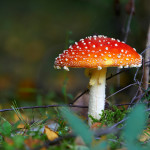 Fungi are very important in maintaining the soil health. They serve three main functions, breaking down woody organic matter (specifically cellulose), adding structure to the soil, and helping plants get water and nutrients. For example, one of the beneficial fungi is Mycorrhizae, which attach themselves to the plant roots and act as a fine mess of feeder rootlets sucking nutrients and water from the soil to the plant’s roots. The plants actually encourage this, buy sharing energy with the fungi in the form of exudates. A healthy soil contains more fungi than the bacteria.
Fungi are very important in maintaining the soil health. They serve three main functions, breaking down woody organic matter (specifically cellulose), adding structure to the soil, and helping plants get water and nutrients. For example, one of the beneficial fungi is Mycorrhizae, which attach themselves to the plant roots and act as a fine mess of feeder rootlets sucking nutrients and water from the soil to the plant’s roots. The plants actually encourage this, buy sharing energy with the fungi in the form of exudates. A healthy soil contains more fungi than the bacteria.
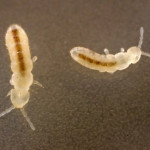 Arthropods are natural recyclers that control the population of soil organisms by feeding on them, thus maintaining the balance in the soil food web. Arthropods are soil creatures which feed on dead plant material and other soil organisms like bacteria, fungi, and earthworms. The family arthropods include very small soil organisms like mites and large organisms like bugs, springtails, spiders, and centipedes. The small arthropods, which are generally referred as microarthropods, consume organic mater and release nitrogen and other nutrients back into the soil for use by your plants.
Arthropods are natural recyclers that control the population of soil organisms by feeding on them, thus maintaining the balance in the soil food web. Arthropods are soil creatures which feed on dead plant material and other soil organisms like bacteria, fungi, and earthworms. The family arthropods include very small soil organisms like mites and large organisms like bugs, springtails, spiders, and centipedes. The small arthropods, which are generally referred as microarthropods, consume organic mater and release nitrogen and other nutrients back into the soil for use by your plants.
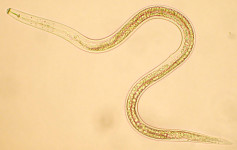 Nematodes are unsegmented worms with a long rounded body with points at the both ends. Some nematodes are free-living, others are parasites, some are beneficial and others pathogenic. The beneficial nematodes feed on other soil organisms like bacteria, protozoa, beneficial nematodes, and pathogenic nematodes. They excrete waste which contains Nitrogen and other vital nutrients for the plants. The beneficial nematodes support root growth through their excretions and control the pathogenic nematodes, whereas pathogenic nematodes feed on roots of your plants.
Nematodes are unsegmented worms with a long rounded body with points at the both ends. Some nematodes are free-living, others are parasites, some are beneficial and others pathogenic. The beneficial nematodes feed on other soil organisms like bacteria, protozoa, beneficial nematodes, and pathogenic nematodes. They excrete waste which contains Nitrogen and other vital nutrients for the plants. The beneficial nematodes support root growth through their excretions and control the pathogenic nematodes, whereas pathogenic nematodes feed on roots of your plants.
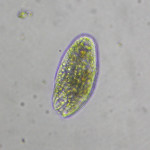 Protozoa in the soil are unicellular organisms. They have two purposes; they eat bad bacteria that harm plants as well as excrete waste rich in Nitrogen and other nutrients. Protozoa can be divided into three groups:
Protozoa in the soil are unicellular organisms. They have two purposes; they eat bad bacteria that harm plants as well as excrete waste rich in Nitrogen and other nutrients. Protozoa can be divided into three groups:
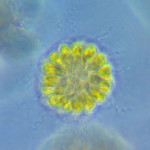 Flagellates: These are chlorophyll-containing as well as non-chlorophyll organism mostly found in the soil. Flagellates are the smallest organism in protozoa family.
Flagellates: These are chlorophyll-containing as well as non-chlorophyll organism mostly found in the soil. Flagellates are the smallest organism in protozoa family.
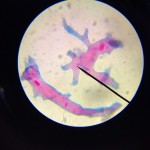 Amoebae: These organisms are larger than flagellates. They are food for other organisms. They also excrete nutrients for plants.
Amoebae: These organisms are larger than flagellates. They are food for other organisms. They also excrete nutrients for plants.
 Ciliates: These are the largest organism of the protozoan family. They feed on organic waste and other organisms. The ciliate waste contains nutrients for the plants as well as food for other organisms. (Tiarina fusus – The mouth end of this marine ciliate is on the right. It has calcium carbonate plates (the beaded surface). It feeds on microscopic algae.)
Ciliates: These are the largest organism of the protozoan family. They feed on organic waste and other organisms. The ciliate waste contains nutrients for the plants as well as food for other organisms. (Tiarina fusus – The mouth end of this marine ciliate is on the right. It has calcium carbonate plates (the beaded surface). It feeds on microscopic algae.)
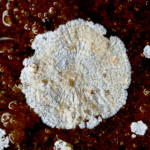 Actinomycetes are classified as bacteria, but they share some characteristics with fungi. The similarities of actinomycetes with fungi include shape, spore formation, branching, and metabolite production. One of the interesting properties of actinomycetes is the production of antibiotics. Actinomycetes produce streptomycin, neomycin, erythromycin, and tetracycline. These antibiotics are used in the medical science to treat various diseases.
Actinomycetes are classified as bacteria, but they share some characteristics with fungi. The similarities of actinomycetes with fungi include shape, spore formation, branching, and metabolite production. One of the interesting properties of actinomycetes is the production of antibiotics. Actinomycetes produce streptomycin, neomycin, erythromycin, and tetracycline. These antibiotics are used in the medical science to treat various diseases.
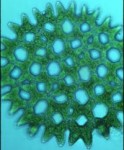 Algae are chlorophyll-containing aquatic organisms that do not have stems, roots, and leaves. This is the stuff that makes your pool turn green. Since Algae contains chlorophyll, they can make their own nutrients by absorbing sunlight and making carbohydrates from carbon dioxide and water. Algae also have nitrogen fixation properties. They release vital nutrients to the soil thus maintaining the soil health.
Algae are chlorophyll-containing aquatic organisms that do not have stems, roots, and leaves. This is the stuff that makes your pool turn green. Since Algae contains chlorophyll, they can make their own nutrients by absorbing sunlight and making carbohydrates from carbon dioxide and water. Algae also have nitrogen fixation properties. They release vital nutrients to the soil thus maintaining the soil health.
The Soil Food Web
Living things that produce their own energy are call autotrophs. Plants are autotrophs, they are also called producers. The primary producers for the soil food web are plants, lichens, moss, photosynthetic bacteria, and algae. These producers create energy for themselves and also for other organisms. Living things that cannot make their own energy are called heterotrophs. Heterotrophs are consumers, they get energy from other heterotrophs or autotrophs.
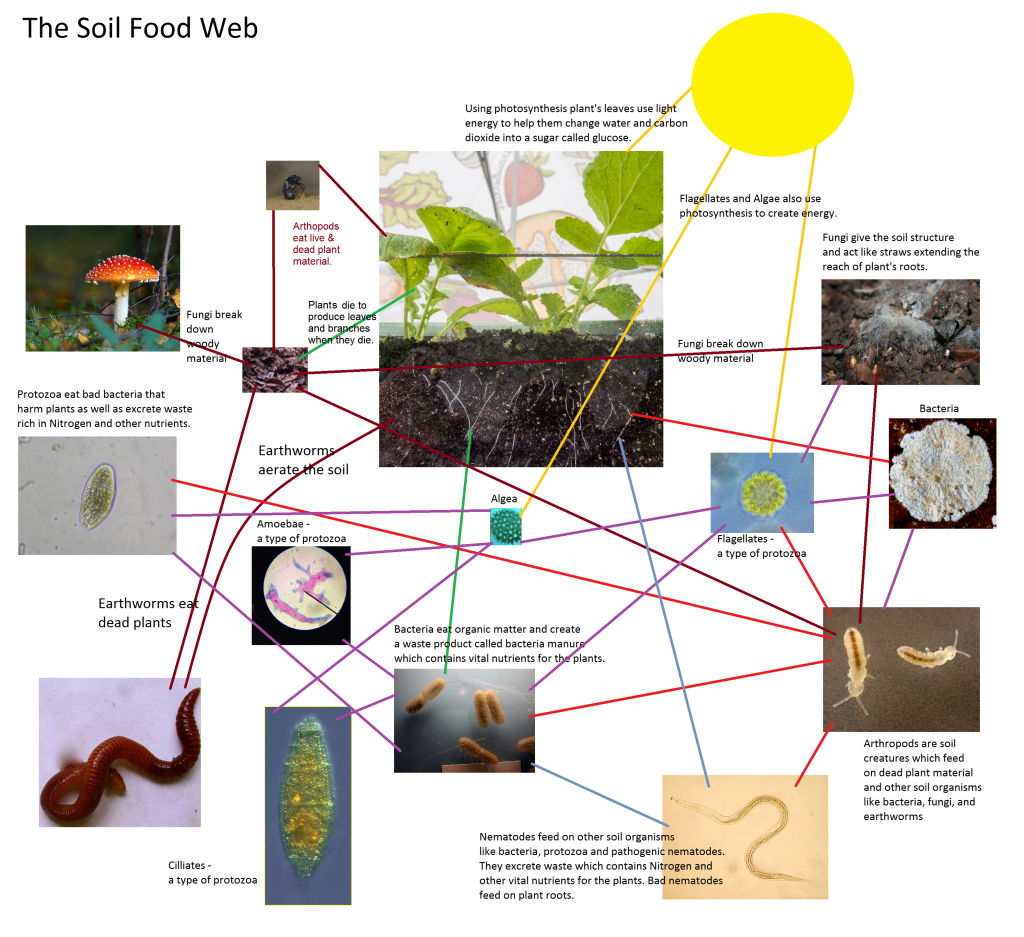
Plants produce energy, however, in order to produce the energy they need sunlight, water, and nutrients from the soil. In the soil, there lives a community of organisms. The soil food web is the community of living organism in the soil. It is through this web of production and eating each other that energy is transferred between all the various species.
Where Do Soil Organisms Live?
The soil environment is the determining aspect for the availability and growth of the soil organism. The soil organisms live within and between soil particles, in and around the plant roots, inorganic waste, and organic matter. The habitat of the soil organism depends on the microscale environments, the difference in pH distance, pore size, moisture, and the types of food available for them.
As we said earlier, a teaspoon of soil can contain Billions of soil organisms. However, these organisms are not found in the same number everywhere. Their population is densest where each species can find favorable living conditions such as nutrients, moisture, and space. These conditions can usually be found where there is organic matter, usually in the few inches of the earth surface. The soil organisms are mostly concentrated in the following areas:
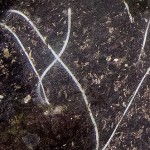 Near plant roots: The narrow area of soil in and around roots is called rhizosphere. Bacteria, protozoa, and nematodes are concentrated in the rhizosphere. Bacteria feed on proteins and sugars released by the roots and sloughed-off plant cells. The protozoa and nematodes feed on bacteria. When protozoa and nematodes excrete, they release nutrients for the plants. This creates a vibrant area of life and is the best place to find microbes.
Near plant roots: The narrow area of soil in and around roots is called rhizosphere. Bacteria, protozoa, and nematodes are concentrated in the rhizosphere. Bacteria feed on proteins and sugars released by the roots and sloughed-off plant cells. The protozoa and nematodes feed on bacteria. When protozoa and nematodes excrete, they release nutrients for the plants. This creates a vibrant area of life and is the best place to find microbes.
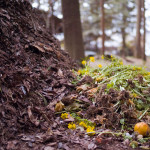 In Organic Matter: Plant-based litter, such as shredded leaves, is a great place to find microbiology. The organic matter attracts earthworms and arthropods, which break down the organic matter into tiny pieces. Then the Fungi pull Nitrogen from the soil and break down the complex and hard-to-decompose brown carbon rich debris tied up in the plant cell walls. Meanwhile bacteria are also working on breaking down this litter even further. However, bacteria can’t gather Nitrogen like the fungi can, so it prefers green waste, but will settle for a well mixed compost pile so it can gain access to Nitrogen. Then of course, where you have bacteria and fungi you have protozoa and nematodes joining in on the feast.
In Organic Matter: Plant-based litter, such as shredded leaves, is a great place to find microbiology. The organic matter attracts earthworms and arthropods, which break down the organic matter into tiny pieces. Then the Fungi pull Nitrogen from the soil and break down the complex and hard-to-decompose brown carbon rich debris tied up in the plant cell walls. Meanwhile bacteria are also working on breaking down this litter even further. However, bacteria can’t gather Nitrogen like the fungi can, so it prefers green waste, but will settle for a well mixed compost pile so it can gain access to Nitrogen. Then of course, where you have bacteria and fungi you have protozoa and nematodes joining in on the feast.
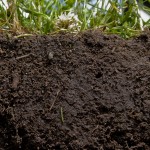 In Raw Soil: The soil contains clay, sand and organic waste (usually, feces of earthworms and arthropods) which is commonly referred as soil aggregates. Soil organisms, mostly bacteria, and fungi are more active on the surface of soil aggregate than within the soil aggregate. The larger critters, like arthropods and nematodes, live between the particles and move in the spaces between the soil aggregates. They can also be found is small water filled pores within the soil.
In Raw Soil: The soil contains clay, sand and organic waste (usually, feces of earthworms and arthropods) which is commonly referred as soil aggregates. Soil organisms, mostly bacteria, and fungi are more active on the surface of soil aggregate than within the soil aggregate. The larger critters, like arthropods and nematodes, live between the particles and move in the spaces between the soil aggregates. They can also be found is small water filled pores within the soil.
When Are Soil Organism Active?
Different soil organisms are active at different times. They each follow daily patterns as well as seasonal patterns and are generally not all active at the same time. They are most active when there is enough moisture and the soil temperature is favorable. Depending on the species of soil organism, they can be active in the late spring, in the rainy season, in the winter and/or the dry season. When the temperature and climate are not favorable, they remain dormant.
The Importance of the Soil Food Web in Plants Growth
The soil food web is a very important player in the plant kingdom. The soil food web has an incredible diversity of organisms that range from the minute unicellular bacteria, protozoa, algae, and fungi to the complex micro-arthropods and nematodes, and the visible insects, small vertebrates, earthworms, and plants. These organisms interact with each other as well as with the soil and plants. The result is increased soil fertility, reduction of harmful pathogens and pests, and better water absorption and retention.
The soil organisms decompose organic matter and recycle nutrients. The soil organisms receive energy and carbon by feeding on the organic compounds released plants, other organisms, and dead plant matter. When the soil organisms consume other soil organisms and decompose complex organic materials, they cycle and release nutrients back into the soil. Plants and other soil organisms feed on these nutrients. The soil organisms also trap nitrogen from the air and make it available for the plants.
All kinds of plants are dependant on the soil food web for their nutrition. The soil food web is a complex network of living organisms and every ecosystem has it own unique food web composed of different organisms. The soil food web also has an important role to play in the management of farmland, grazing land, forestlands, and gardens. It also affects the food production, biodiversity, carbon sequestration and air and water quality. A healthy soil food web is key to healthy plants and a healthy world.
In a healthy soil food web your plants will be covered from leaf to root with beneficial microbes, which will act like a shield protecting your plants from all the pest pathogens. Not only will these microbes protect your plants, when you eat them, they will help your gut function properly.
So what exactly are the microbes eating? Organic Matter
The soil food web has a deep relationship with organic matter. Organic matter is not only a breeding ground for soil organisms but it is also food for many of the organisms in the soil food web. Here are the different classes of organic matter:
Living organisms: The organic matter in soil consists of minute as well as visible organisms such as bacteria, protozoa fungi, earthworms, nematodes, arthropods, and plants.
Active fraction organic matter: The simple organic compounds that microorganisms feed on.
Labile organic matter: The organic matter which can easily decompose.
Root exudates: Amino acids, soluble sugars, proteins, carbohydrates and other compounds secreted from the plant roots.
Lignin: Fungi feed on the carbon ring structures in lignin. Lignin is a hard-to-decompose compound which is a part of the fibers of the older plants.
Recalcitrant organic matter such as lignin or humus which are decomposed by soil organisms.
Humus or humified organic matter is complex organic compounds left after soil organisms have recycled the organic matter many times. Humus does not easily degrade because it is chemically complex or physically protected inside soil aggregates. Humus improves soil aggregates by improving nutrients and water holding capacity in the soil.
Detritus and surface residue from dead plant or organic material: These are the substances from animals, plants or other organic matter that have just been added to the soil and have just begun to decompose. Some organism such as detritivores feeds on these decaying materials.
Remember when we did our jar test to figure out composition of your soil? Well it was only showing you part of the organic matter; the larger pieces. The microscopic stuff got mixed up into the water.
Applying Soil Food Web to our Garden and Cropland
To grow the best crops we need to help our plants get the water, and nutrients they need by encouraging the helpful organisms, or Biota, and discouraging the not helpful ones, or Pathogens. We do this by supporting the soil food web and we do that by feeding the soil the proper nutrients with organic fertilizers. If the soil food web is functioning smoothly, then it will support the growth of helpful soil biota and suppress pathogens on its own. It is our goal to provide the soil with the largest diversity of microbiology so that the plants can pick and choose the ones it wants and needs to thrive.
Here are some do’s and don’ts to help you encourage the health of your soil food web.
- Do feed the soil food web with compost or organic fertilizers. More on this below.
- Do protect the soil and the microbes by using mulch. More on this below.
- Don’t using chemical fertilizers – It is important to avoid chemical fertilizers. The chemical fertilizers may help your plants grow big, but they will also weaken your plants. This encourages pest insects. At the same time the salts in the fertilizers create a hostile environment in the soil, making it difficult for the microbes to thrive.
- Don’t use pesticides – The danger in using pesticides is that, if you’re not careful, you will kill the beneficial organisms as well as the pathogenic organisms. Targeted organic pesticides reduce this risk.
- Don’t use fungicides or herbicides – Glyphosate and other herbicides like the ones found in RoundUp, have been found to negatively effect the populations of many beneficial microbes and soil fauna. Things like earthworms and mycorrhizal fungi are inhibited which reduces soil fertility, aeration and plant drought tolerance.
- Do not compact your soil – the good microbes need oxygen to survive and thrive. If there is a lack of oxygen, other microbes will thrive many of which create toxic compounds like alcohol. All of the disease causing organisms flourish in an anaerobic environment. Getting oxygen into your soil is critical for keeping them in check.
- Don’t till if possible – In order to increase aeration in the soil many farmers and gardeners till the soil. Ironically, tilling the soil tears apart the complex network of fungi and kills many of the larger fauna like earthworms and protozoa. The exact things that allow your soil to breath.
- Instead of tilling – mark off your garden area and stop walking on and compacting your soil. Mulch also helps attract the proper fauna, which will do the work of aerating the soil on your behalf.
Woodland soil has more fungi in it than most home gardens. That’s because most people tend to remove leaves and other organic waste from the garden in the name of cleaning the garden. Plants grow better when there are fungi present. Therefore, it is best to keep the leaves and other organic waste to decompose and return to the soil. In order to maintain soil health, we need to promote fungal growth in the soil. We can do this by allowing leaves and another organic waste to decompose in our garden, just like it does in the forest. Organic waste provides a breeding ground for fungi.
How to restore and Maintain the Soil Food Web
As mentioned earlier we only need to do two things to support a healthy soil food web; feed it and protect it. However, before we go feeding our soil blindly we should test our soil.
Testing the soil biology in our Garden
You can do this in one of two ways, the first way is to find a lab to test the soil for you. The second is to purchase a microscope and test it yourself. If you need a microscope go here: http://www.soilfoodweb.com/Microscopes.html it will cost you about $300.
The test is a fairly simple process. First grab three core samples from the soil around your plant. Then mix them up thoroughly, and put one teaspoon into a jar with 4 teaspoons of clean, non-chlorinated water and shake it up really well. Then take a drop of that water and put it on your slide, put the slide cover on and slide it into your microscope. This is what you want to find in each field of view. You want a good number of bacteria swimming around, at least one strand of fungal hyphae, and one amoeba. You also want to find at least one good guy protozoa or nematode somewhere in the drop as you scan the entire slide.
MORE: If you would like to learn more about identifying the microbes, I highly recommend https://www.lifeinthesoilclasses.com/ Dr Elaine Ingham has a detailed class on learning how to test your soil microbiology.
Feeding the Soil Food Web
Compost
Compost is a mixture of decaying vegetation and manure which is used as an organic fertilizer for the plants. Compost is generated after organic matter is degraded by bacteria, fungi, earthworms and small arthropods. Compost is a breeding ground for soil organisms as it contains favorable environment, moisture, and food for the soil organisms. When you are applying the compost to your garden or farmland, you are basically putting soil organisms and other nutrients directly into your soil. To learn more about compost check out my article on making perfect compost.
Grow Plants
As discussed earlier, plants release food for the microbes directly into the soil through there roots. This food is a complex mixture sugars, carbohydrates, and proteins called exudates. Plants spend 1/4th of the energy they produce on creating this food for the microbiology in the soil. If you’ll notice, Mother Nature puts plants in every nook and cranny she can fit them. Growing cover crops and rotating your fields with help produce a healthier soil.
Encouraging Bacteria
You can encourage the growth of bacteria by releasing your own form of exudate or food into the soil. The main thing that bacteria like to eat is sugar, so feeding your soil sugar will attract more bacteria. The best kind of sugar is molasses because it contains 150 different kinds of sugars. Start by mixing 1 drop of molasses with 1 gallon of water and then test your soil a few days later to see if it where you want it to be. If it still needs more, then try spreading some more again. Plants like brassicas enjoy a bacteria heavy soil.
Encouraging Fungi
To encourage proper fungal growth we only need to feed it. Fungi love to eat cellulose or the cell walls of decaying plant material. So, one of the easiest ways to encourage fungal growth is through organic matter like shredded leaf compost. You can also use some organic fertilizers like a fish hydrolysate or an humic acid.
Protecting the Soil Food Web
Mulch
Mulch also creates a favorable environment for the soil fauna. When you mulch, you are basically spreading decaying organic matter on the top of the soil which feeds the soil food web. This layer of decaying organic matter also blocks the wind and sun from pulling the water out of the soil and helping to keep the soil moist. Mulch also helps prevent erosion by blocking the wind and absorbing excess water before it has a chance to build up and wash the soil away. In addition the fungi in the soil will cling to the mulch and tie everything together. To read more on the best kinds of mulches, please refer to my other article.
MORE: If you would like to learn more about the Soil Food Web, I highly recommend https://www.lifeinthesoilclasses.com/ Dr Elaine Ingham is the real deal and provides great in depth information on how to test your soil, and encourage the good organisms in your soil food web.
References
http://www.sciencedirect.com/science/article/pii/S004896971530989X
https://www.soilassociation.org/media/7202/glyphosate-and-soil-health-full-report.pdf
http://www.theatlantic.com/health/archive/2013/06/healthy-soil-microbes-healthy-people/276710/
https://www.scientificamerican.com/article/microbes-help-grow-better-crops/
http://www.gardeningwithmicrobes.com/livingsoil.shtml
https://www.nrcs.usda.gov/wps/portal/nrcs/detailfull/soils/health/biology/?cid=nrcs142p2_053868


